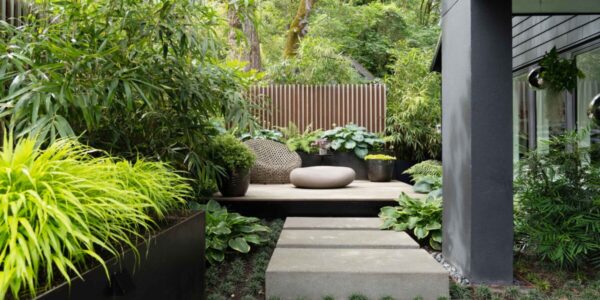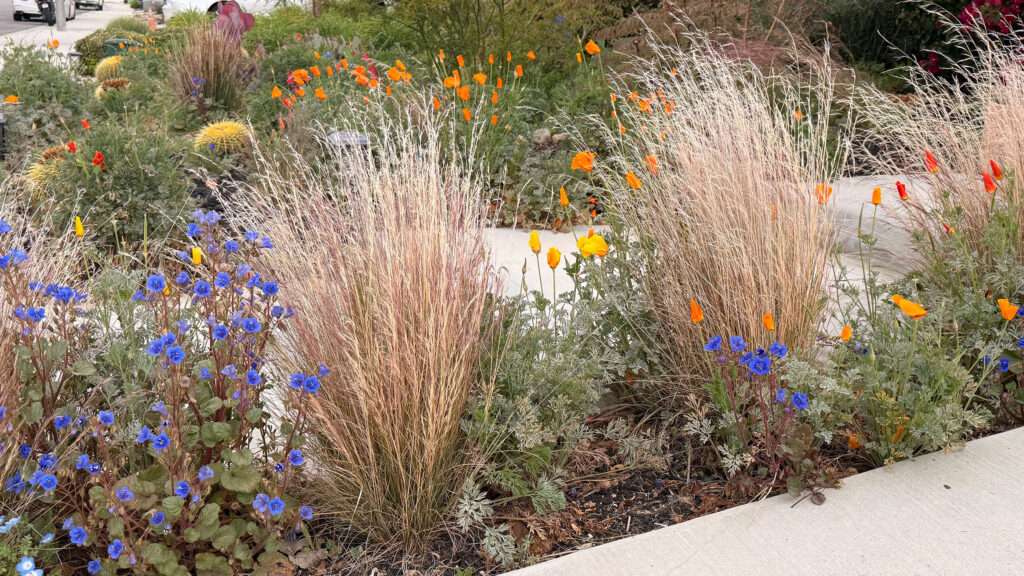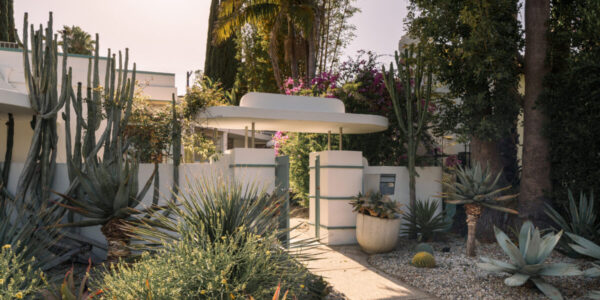
Why ‘Chaos Gardening’ Is the Wild Trend Taking Over Backyards Once Again
How to rethink untamed planting for a more resilient, beautiful backyard.

Courtesy of Big Red Sun
Remember when chaos gardening told us to toss a bunch of seeds and hope for the best? Turns out, that joyful, low-effort approach to planting wasn’t just a social media fling—it’s a full-on movement. And this spring, the trend is growing up. What started as a rebellious reaction to traditional garden planning—throwing down a mix of flowers, herbs, and veggies with minimal fuss—has proven to be more than just good vibes and seed confetti. Gardeners across the West are now blending wildflower spontaneity with structure: self-seeding annuals, native pollinator powerhouses, and perennial “bookends” that hold the whole thing together. The result? A biodiverse, resilient, and artfully messy garden that gives as much as it takes—and returns year after year with new surprises.
To better understand where this trend is headed—and how gardeners can tap into its magic while honoring ecology and design—we turned to two experts reshaping what chaos gardening looks like in the West. Selena Souders, principal designer at Big Red Sun in Venice, brings a bold, design-forward approach that fuses native plants with sculptural structure. Emily Sluiman, California naturalist and Southwest Territory Manager for Star Roses and Plants, leans into restoration, self-seeding natives, and the quiet power of perennials. Together, they’re laying down the new rules of chaos—where wild meets wise, and beauty grows with intention.

Courtesy of Big Red Sun
Chaos Gardening 2.0
Once seen as impulsive seed-slinging, chaos gardening has evolved into something more intentional—and liberating. The core idea remains: Let go of rigid plans, mix seeds, and let nature do the rest. But version 2.0 brings in design-thinking, native plants, and strategic self-seeders for long-term payoff.
For Emily, the appeal lies in how it mirrors real life—layered and nonlinear. “My garden has no defined ‘style,’” she says. “Is it Mediterranean? Cottage? Desert? Meadow? It’s a hodgepodge.” Her space becomes a wildflower haven in spring—proof that vibrancy thrives in unpredictability.
Selena echoes this from a design perspective: “Gardening is a bit chaotic, so the two go hand-in-hand. Without the chaos in nature, we’d lose the organic beauty that comes from happy accidents.” Still, intention plays a role. “Your palette is your paint, and the garden is your canvas.”
This next wave of chaos gardeners embraces ecological awareness and a “leave the leaves” ethos as much as it does seed tossing. It’s wild, but it’s wise.

Courtesy of Emily Sluiman
Groundwork: Soil, Site, and Water
A thriving chaos garden starts below the surface—with smart soil care and water awareness tailored to the West.
“Research!” says Emily. “Find out which annuals grow in your region—Calscape is a great tool.” Instead of generic mixes, she recommends seed from local CNPS chapters or sources like the Theodore Payne Foundation. Soil type matters too: “Sandy and loamy? Or clay? That helps determine plant survivability and watering needs.”
Selena adds, “Always bring in as much organic matter and mineralized amendments as possible—decomposed granite, compost, whatever suits your region.” A solid foundation supports plants through the West’s dry-down periods.
As for watering, Emily shares Mike Evans’ “Deep Soak, Refreshing Sprinkles” approach: a few deep early-morning waterings every 4–6 weeks, paired with light afternoon sprinkles to cool the soil and perk up plants.
Mulch is helpful… eventually. “If you mulch too early, it can block germination,” says Emily. “But once seedlings are up, mulch protects them from heat, critters, and moisture loss.”
And expect the unexpected. “Be prepared to be surprised and excited,” says Selena. “Plants will work hand-in-hand—or leaf-in-leaf—to create their own meadow language.”

Courtesy of Big Red Sun
Plants: Seeds, Self-Starters & Perennial Anchors
A good chaos garden balances spontaneity and structure. The trick? Mix self-sowing wildflowers with perennial anchors that bring rhythm to the riot.
Emily loves California natives that return and evolve. “Lupinus sp. come as annuals, perennials, and woody shrubs! The annuals reseed more profusely.” Other favorites: California poppy (Eschscholzia californica), which hybridizes into new colors; Phacelia, Gilia, Nemophila, and cobwebby thistle (Cirsium occidentale).
Selena’s wild favorites include little bluestem, cosmos, milkweed, salvias, and pavonia—plants that invite biodiversity while thriving in loose arrangements.
To ground the garden, both designers use strong perennial elements. “You can’t go wrong with salvias, rosemary, monardas, and ground covers like frog fruit or Dichondra,” says Selena. Emily points to Ceanothus, manzanita, and Epilobium—great pollinator draws with visual heft. “Buckwheats (Eriogonum sp.) are a keystone species,” she adds, while penstemons and monkeyflowers (Diplacus sp.) offer structure and seasonal color.
When chosen with care, the plant palette feels intentional—even when it looks wild. Like a meadow that designed itself, with a little creative nudge.

Courtesy of Emily Sluiman
New Rules of Chaos: Ecological Design Meets Personal Style
Chaos doesn’t mean careless. It means leaning into what the land wants to be.
“Nature is wild,” Emily says. “How many landscapes on a hike follow straight lines?” She encourages gardeners to mimic their favorite wild spaces and increase plant variety to attract a broader range of pollinators, birds, and beneficial bugs.
Selena agrees: “Gardens serve beauty and ecology—not just for us, but for all the birds, bugs, and butterflies we love seeing.” In her view, this isn’t just a design choice—it’s part of a necessary shift. “This has to be how we design landscapes in the West. Climate change is happening.”
While rooted in ecology, both experts bring artistic sensibility to the chaos. Emily often builds her palette around a single plant or color family and stays on top of light maintenance—trimming, deadheading, light weeding—to keep things vibrant but not overly curated.
She’s even made chaos gardening work in HOA neighborhoods, using year-round structural plants and layering in wildflower bursts. “There’s always something blooming, even while other things go dormant or fade,” she adds.
The chaos garden isn’t just a style—it’s a quiet rebellion against sameness. It celebrates what’s unpredictable and imperfect, asking us to plant with intention, not ego.
It’s the West, after all—what better place to let the wild in?
